More than a million people are estimated to have died in the Killing Fields
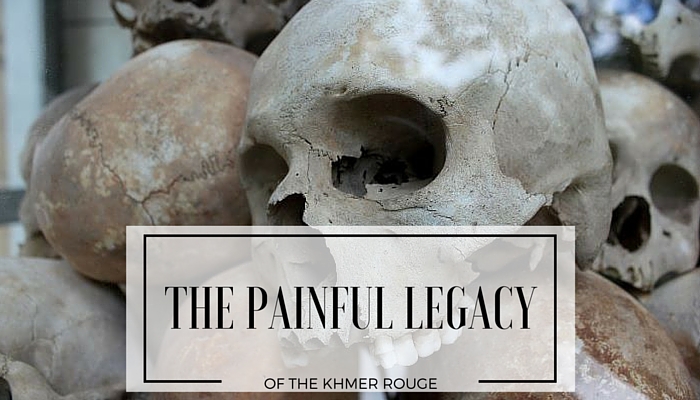
Studying Indochina
Studying Indochina politics as a teenager, learning of the damages suffered by this mysterious, far away country, I could only imagine the horrors inflicted on the elderly, educated, women and children. More than 1.7 million died at the hands of Khmer Rouge yet all that pain and destruction seemed little more than a scene from a horror movie to be quickly switched off and forgotten.
Absorbed in my own teenage dramas (you know the kind – what am I going to drink tonight, am I ever going to find a decent boyfriend, will I ever get a job and be able to leave home?) atrocities committed within my lifetime seemed a world apart.
Fast forward twenty years
Almost twenty years later and I’m about to experience first-hand that devastation. I’m heading to two of the most traumatic ‘tourist attractions’ (I use this term lightly as there is nothing attractive about these sites!) I have ever visited.
I’m about to relive the horrors of an entire nation, whole generations who have to live with the aftermath of an evil plague that destroyed their country in the 1970s, leaving it a shadow of its former self, a crumbling wreck, its inhabitants’ souls shattered to pieces by the scourge which swept through their villages and cities, turning families against one another, children into soldiers and the educated into the enemy.
A brief look at Cambodia’s history
For those unfamiliar, Cambodia in the 1970s was deeply unstable. A coup in 1970 led to years of civil war between Lol Non’s troops and the communist North Vietnamese who occupied large swathes of land in the East.
To further aggravate the situation, this unrest was magnified by the secret war – four years of relentless bombings of suspected communist camps by the Americans resulting in the indiscriminate deaths of thousands of innocent civilians. Ironically, their quest to drive the communists from the country inadvertently may have driven many of the uneducated peasants and refugees, displaced by the bombing, straight into the arms of the Khmer Rouge.
Abject poverty, shortages of food and goods and the ineffectual leadership of Lol Non ultimately resulted in his overthrowing by the Khmer Rouge, led by Pol Pot. Pol Pot’s goal was one of the most:
‘brutal restructurings of a society ever attempted; its goal was a pure revolution, untainted by those that had gone before, to transform Cambodia into a peasant-dominated agrarian cooperative’ Source: Lonely Planet
Little educated, the Cambodians initially viewed him as a saviour sent to rescue them from despair. Little did they realise, Pol Pot was the devil in disguise, a megalomaniac whose only interest was in conducting some bizarre social experiment transforming Cambodia into a rural agrarian society.
The Khmer Revolution
On the 17th April 1975, Khmer Rouge troops swept into the streets of Phnom Penh rounding up families who had but a few hours to pack their belongings and join the snaking convoys of people being herded from the city. Some were lucky enough to leave in cars or carts, others were forced to walk, straining under the weight of their possessions.
Hospital patients were unceremoniously tossed into the street with scant regard for their condition, those who could trying valiantly to assist them, many of the sick too weak to survive even this first day of horror.
For days, thousands of Cambodians would be encouraged onwards by gun wielding soldiers, on a perilous march into the unknown. Checkpoints would sort the educated for ‘work duties’: teachers, doctors, civil servants and those speaking foreign languages were systematically rounded up and executed by the roadside, as Pol Pot and his men unleashed their fury.
Welcome to hell
Others fortunate enough to continue their walk of death, would ultimately come to reside in poverty stricken villages where a Khmer Rouge leader would continuously spout the party propaganda of agrarian values.
In these simple workcamps, forced to wear the black robes of the Khmer Rouge they would be subjected to harsh days of 12 – 15 hours of forced labour, with minute portions of food to sustain them. Anyone daring to attempt to siphon extra food for their families would be severely punished or simply executed as a warning to others.
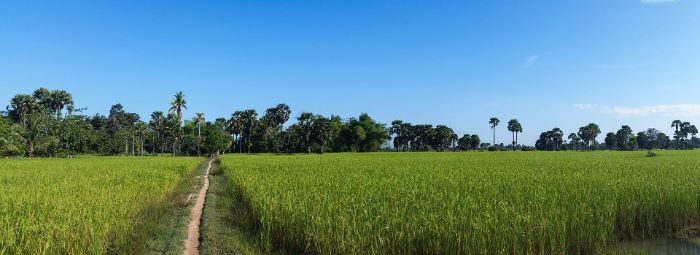
Disease and starvation
Many would soon succumb to disease, starvation, beatings or execution for some minor demeanour.
People posing a threat to the regime would be picked up and taken away on lorries to the S-21 prison in Phnom Penh. Following enforced admissions of treason, from there they were packed into lorries and driven out to the peaceful village of Cheung Ek. There, in beautiful countryside surrounded by rice fields, they would be savagely herded into pits to become victims of mass shootings or be bludgeoned to death. Many were forced to suffer for days due to the scarcity of bullets, trapped under bodies of the dead, slowly suffocating to death.
Whole families would be targeted during the Cambodian genocide – after all a child, wife or mother of a ‘convicted traitor’ posed a future potential threat to the security of the regime. Children, babies, women and the elderly were taken away to suffer horrific fates at the hands of the regime.

Reliving the horror
So it is that on a hot, sultry day in January, my husband and I are about to see first-hand the scene of such devastation. First we head to the S-21 prison, an old high school in an unmemorable street on the outskirts of Phnom Penh. Wedged in between residential properties, its soot covered walls look unremarkable from the outside.
Like any other school, buildings ring a courtyard with benches and exercise areas. Unlike any other school, these buildings were witness to some of the most horrific interrogations, and tortures designed to illicit confessions of betrayal.
The Khmer Rouge documented much of the activity and photographs adorn the wall, an enduring memorial to those who suffered despair, confusion and suffering at the hands of this barbaric regime.
 |
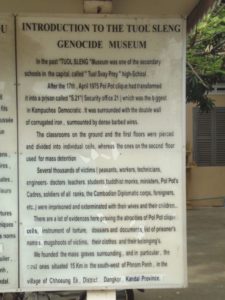 |
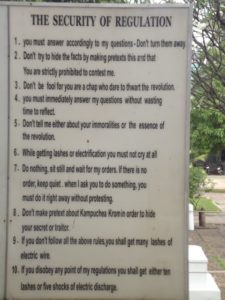 |
Frankly I find it difficult to stomach and have to rush outside to take in deep breaths of fresh air.
14,000 prisoners walked through these gates and only seven survived.
One holds court in the shade of the courtyard, a frail, friendly looking chap regaling his audience with stories of terror and misery. I find myself blinking back tears, trying to imagine the horrors he witnessed.
The Killing Fields
From here, we re-join our tuk tuk for the 15km drive to the Killing Fields. It is stifling hot, exhaust fumes linger in the air and dust stings our eyes as we trundle down roads which have witnessed suffering beyond comprehension.
A short drive from the highway, surrounded by rice paddies, farmland and little hamlets, is a mass graveyard, the scene of mass genocide knowing no boundaries.

A tower of skulls
A shocking memorial to the dead greets you as you arrive, a huge tower, crammed with over 8,000 skulls and exhumed bones from the site. It is a chilling and poignant memorial which stuns visitors to silence.
Tourists wander unchecked around the burial grounds, occasionally unwittingly stepping on shards of bones or clothing, a sad reminder of an unfortunate victim. I find myself imagining horrific scenes, brought to life through the haunting audio tour which accompanies our visit.
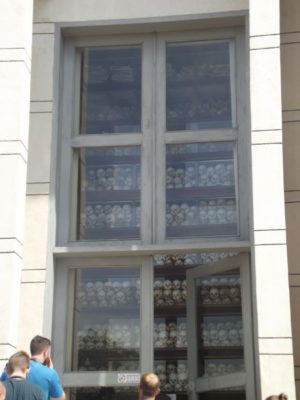 |
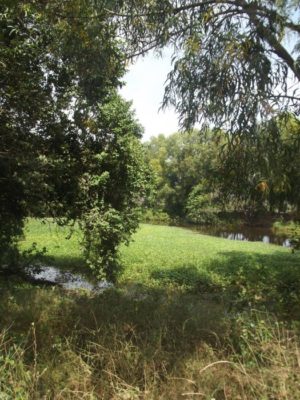 |
 |
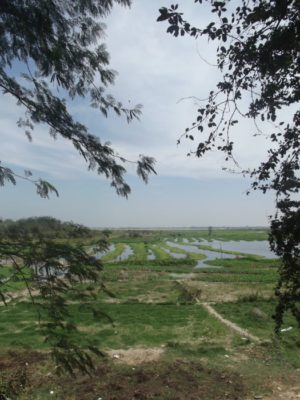 |
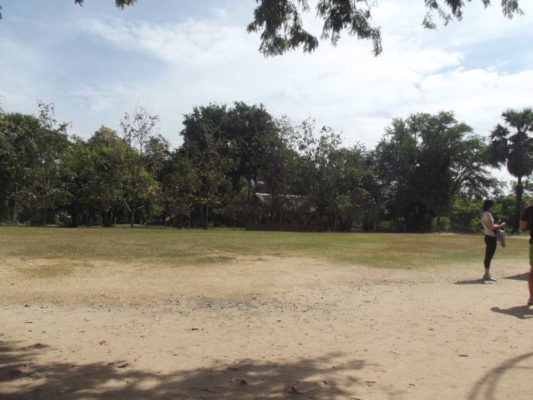
I envision herds of bewildered, silent men and women brutally pushed into the pits to await their horrific fate. I feel their fear, the pain of knowing they will never be reunited with their loved ones, their loss of self-worth, identity and pride. I feel the trauma of their families – fathers, brothers, mothers and sisters left behind to wonder what became of them, to hope they didn’t suffer, to hope they are alive somewhere beyond their reach.
So moved am I that I need to be alone. I visit the Chankiri tree reserved for the cruel battering of babies alone, trying hard to suppress the howls that want to escape me. It is inconceivable to imagine the utter desperation of a mother watching her child be brutally murdered in this manner and I struggle to retain my composure, my soul heavy with the sorrow of countless lost spirits.
Today the tree is adorned with hundreds of string bracelets, a youthful memorial to those young lives lost in a time of madness.
It’s hard to fathom that in this place so many people died, while villagers worked in the fields nearby, oblivious to the horrors taking place on their doorstep. We leave with heavy hearts feeling forlorn and empty, knowing this won’t be the last time we see this kind of mass killing.
A traumatic visit
Visiting the Killing Fields leaves me incredibly saddened. Imagining the thoughts of those who came here, unceremoniously executed by heartless individuals, many of whom never saw justice, breaks my heart.
Just trying to capture these memories has me in tears. It may have been almost 18 months since our visit, but the horror of the site has not diminished. Unfortunately, this kind of Genocide has been repeated time and time again since the days of the Khmer Rouge, be it in Africa, the Balkans or in Syria.
The legacy of the Khmer Rouger period
It is estimated that around 1.7 million people, around 20%, of the Cambodian population, were killed during the three years, eight months and 20 days of the Khmer Rouge rule. Many were executed, whilst many died of overwork, famine and disease. An entire generation of educated people were wiped out to be left with a peasant society with little prospect of being able to rebuild a nation.
It is impossible to visit Cambodia today and not see the impact of this period on the country – a country struggling to rise from the ashes and regain the prosperity it experienced in the 1960s. Having travelled from neighbouring Vietnam, it is easy to see that Cambodia is seriously behind in its infrastructure and it will take time to recoup the loss of many of its educated population. In Phnom Penh it is not uncommon to see young mothers selling wares by the roadside while their babies and toddlers sleep on park benches behind them, a sight I found particularly upsetting.
Indeed, a visit to Cambodia is not for the faint-hearted. If you venture beyond the party town of Siem Reap and the temples of Angkor be prepared to witness the poverty and corruption of a country trying to regain its place in modern history.
There’s more than one killing field
It is worth noting that whilst Cheung Ek may be the most notorious killing field, it is not the only one. Similar sites existed in many locations around Cambodia serving a similar purpose.
Want to learn more?
I urge you to watch this video, the first of four. WARNING – it is very graphic in parts but will give you a good understanding of the horrors endured by this nation.
Here are some books you may also find interesting. I highly recommend ‘First they took my father’ by Loung Ung. It is one of the most heart-wrenching stories I have ever read but it gives first-hand insight into the daily nightmare of life under Khmer Rouge rule. Have your hankie at the ready!
Should our government help?
The governments of many so called developed nations repeatedly turn a blind eye to human suffering in similiar situations, leaving many with no hope or future and I find myself struggling with the futility of such situations.
This is a heated debate I know – is it our government’s job to try to save everyone? Why don’t the governments of some of these countries (or their immediate neighbours) help these people? Or should we, who have so much more, do more to help those in need? It seems that economics is valued more than human life and this is a reality I find incredibly depressing.
What do you think?
Have you ever visited somewhere which has left a real mark on you? Would you recommend it to others? What do you think? Should our governments help?
Pin this
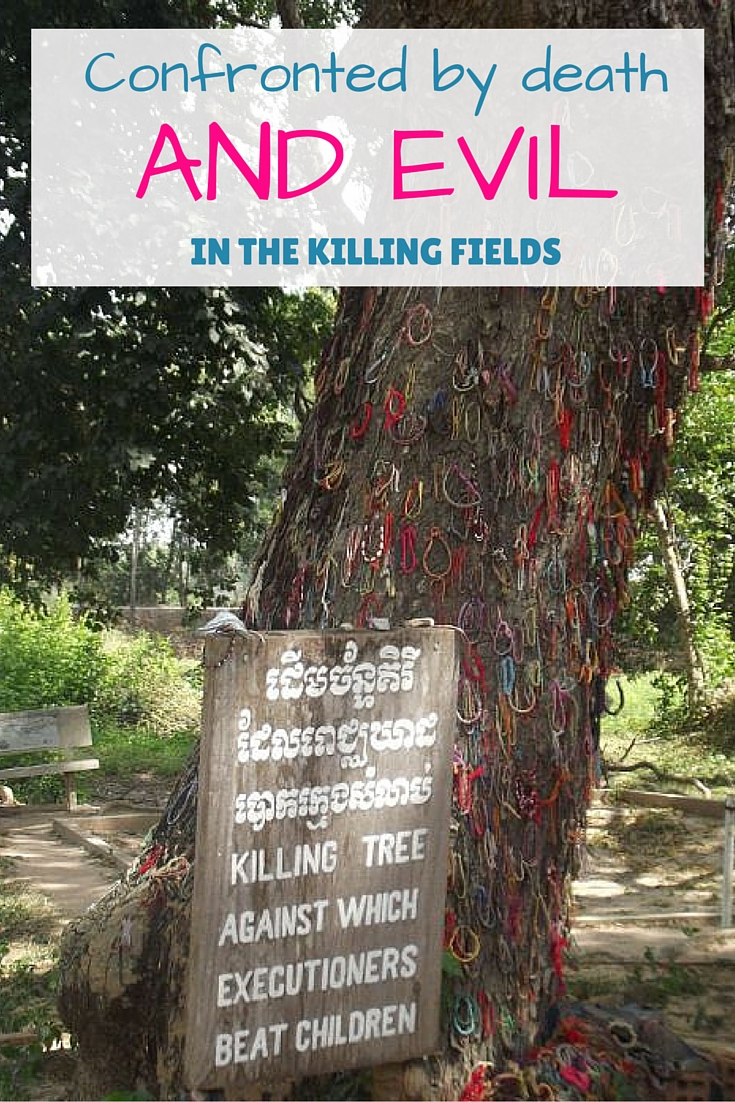
 From Miles to Smiles Stylish travel for professionals seeking luxury at affordable prices
From Miles to Smiles Stylish travel for professionals seeking luxury at affordable prices



I had no idea about this either. Absolutely terrible. It sounds like a very important place to visit and thank you for sharing your experience.
I had no idea all that happened in the killing fields! That tree 🙁 So sad. Also didn’t know there was more than one “killing field” as it were. I’d like to visit, I think. Places like this are a good reality check.
Thank you for sharing your perspective on your visits to S21 and Cheng Ek and raising some important questions too. I live in Phnom Penh now and think it is so important for anyone who comes to Cambodia to learn about the Khmer Rouge genocide and events that took place in the country. This morning I went to the Extraordinary Chambers Court of Cambodia just outside the city to watch the final testimony and trial of Duch, the leader at S21, who is now serving life in prison. He is responsible for the deaths of over 20,000 people who went through Tuol Sleng and were brought to the killing fields. It was so eerie to see him in person, so old and frail yet still fervently answering questions from the prosecution. He maintained that he did not kill anyone with his own hands, and I just cannot understand how he is still saying things like this after 9 years on trial and 40+ years later. There seems to be so little justice now for what the Cambodian people have suffered and continue to be affected by, but the courts are one step in the process.
I cannot imagine how that despicable man can maintain that he is not guilty. He may have not personally killed anyone (although that I seriously doubt that) but he was giving the instructions to others to carry out so it makes him guilty of being an accomplice if nothing else. Jesus, how does the trial even last 9 years? As if the Cambodian people have not suffered enough! I am reading the follow up to ‘First they Killed my father’ currently and it is evident to see just how deep the scars run for those impacted.
This was horrible to read, but necessary. Its hard to imagine how people could do these horrendous things to other people, to children and even babies. I cannot imagine how the families and parents must have felt, or that only seven survived. This must never happen again to any country or in any form.
It’s sad and a shame that despite everything we have “learned” from history that genocides are still occurring (and often with the world’s blind eye turned the other way). Going to the Killing Fields was a chilling experience for us and while making sites like these “touristy” is obviously not the goal, I think it is important for people to see these things and be forced to remember what happened in the HOPES that it can help prevent future ones
I agree with you but unfortunately these types of horrific scenarios continue to occur. We only have to look at Syria and some of the conflicts in Africa in recent times to see that. I think the Killing Fields does a great job of not making it over touristy but not everyone will agree.
We’ve been to both of these sites in Cambodia, and whilst heartbreaking I feel it was necessary to try and understand the horror the Cambodian people have experienced. Thank you for sharing your historical knowledge. It is such an important issue and one that we should learn from to ensure it is never repeated.
I agree wholeheartedly.
I have also studied Indochina and it is pretty incredible the terror some of these countries have suffered. And while in Cambodia I had the impression that it would take a long time for this country to surpass the Khmer Rouge tragedy. We lived some emotional moments there. But it is pretty difficult to say whether out governments should intervene or not. There are a lot of countries that could use our help – such as Cambodia, Tibet, African countries etc. I am for helping them but I am sure that there are many political implications that I might overlook
I’m with you there. In the one hand I think it is wrong to stand by and let so many people suffer, as has happened in recent times in Syria but on the other hand, where does it end? Cambodia was an amazing trip for me but very emotional.
Hello Anne. I’ve been to both of these places in Cambodia. It’s an incredibly difficult experience to go to these places but for the sake of education and learning how wrong things can go in the world, these landmarks being open is doing some good. I commend you on writing about it so openly and can empathise with how terrible you felt. It’s gruelling to say the least. I actually went back to S21 a second time. It was so much to take in on my first visit and I was determined to try and wrap my head around everything. Thank you for sharing.
thanks Alice and great to finally meet you. I don’t think I could stomach s-21 again. It is so raw, so unsterilised (exactly the way it should be) and so saddening. That stupa at the killing fields is so poignant too. Best of luck for your rally. Soooo exciting!
Your best piece. A difficult tale to tell, beautifully told. Xxxx
Thanks Claire. It’s a place I was desperate to visit (so much so that I went despite having sunstroke and throwing up all the night beforehand) but man it was tragic!
Anne, well done on writing such a great article. The tower of Skulls is the thing that hits me most in the face (in terms of a tangible, visual sight). I remember studying PolPot and the Khmer Rouge when I was in school and being horrified by all it then. Having now been to many war sites, war memorials, and concentration camps throughout the world, I still haven’t come to terms with the horror that people were forced to endure. A special piece indeed.